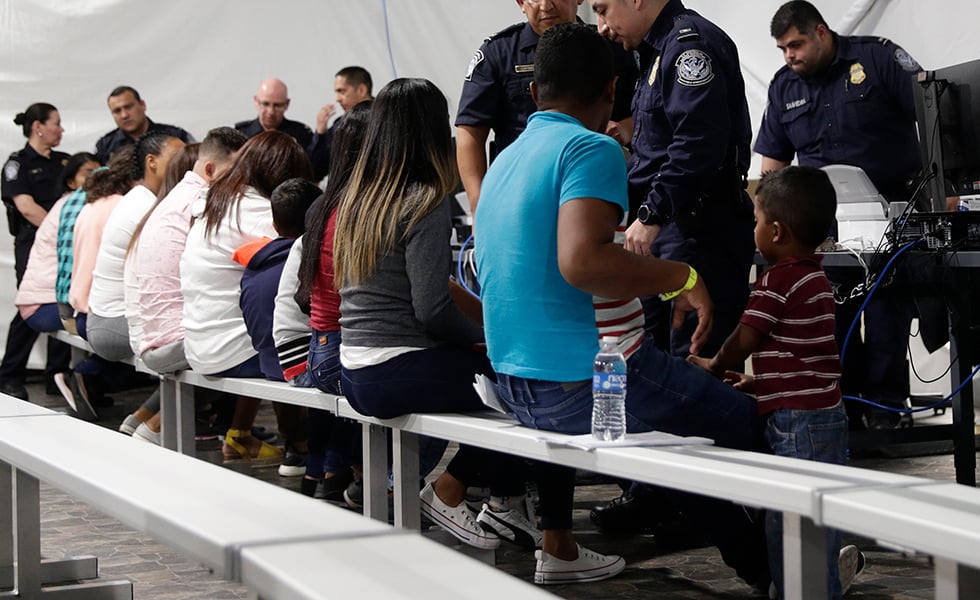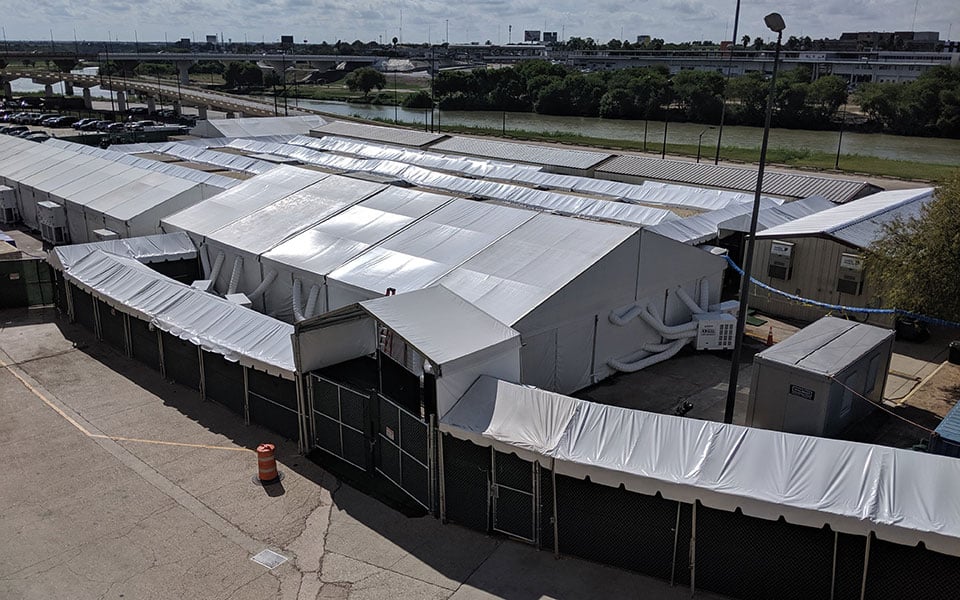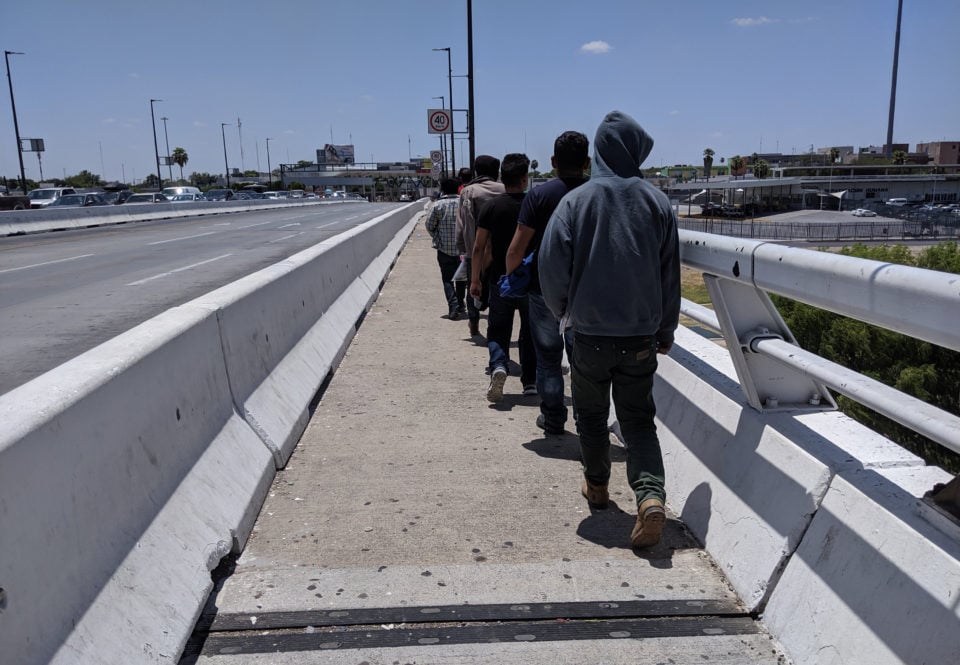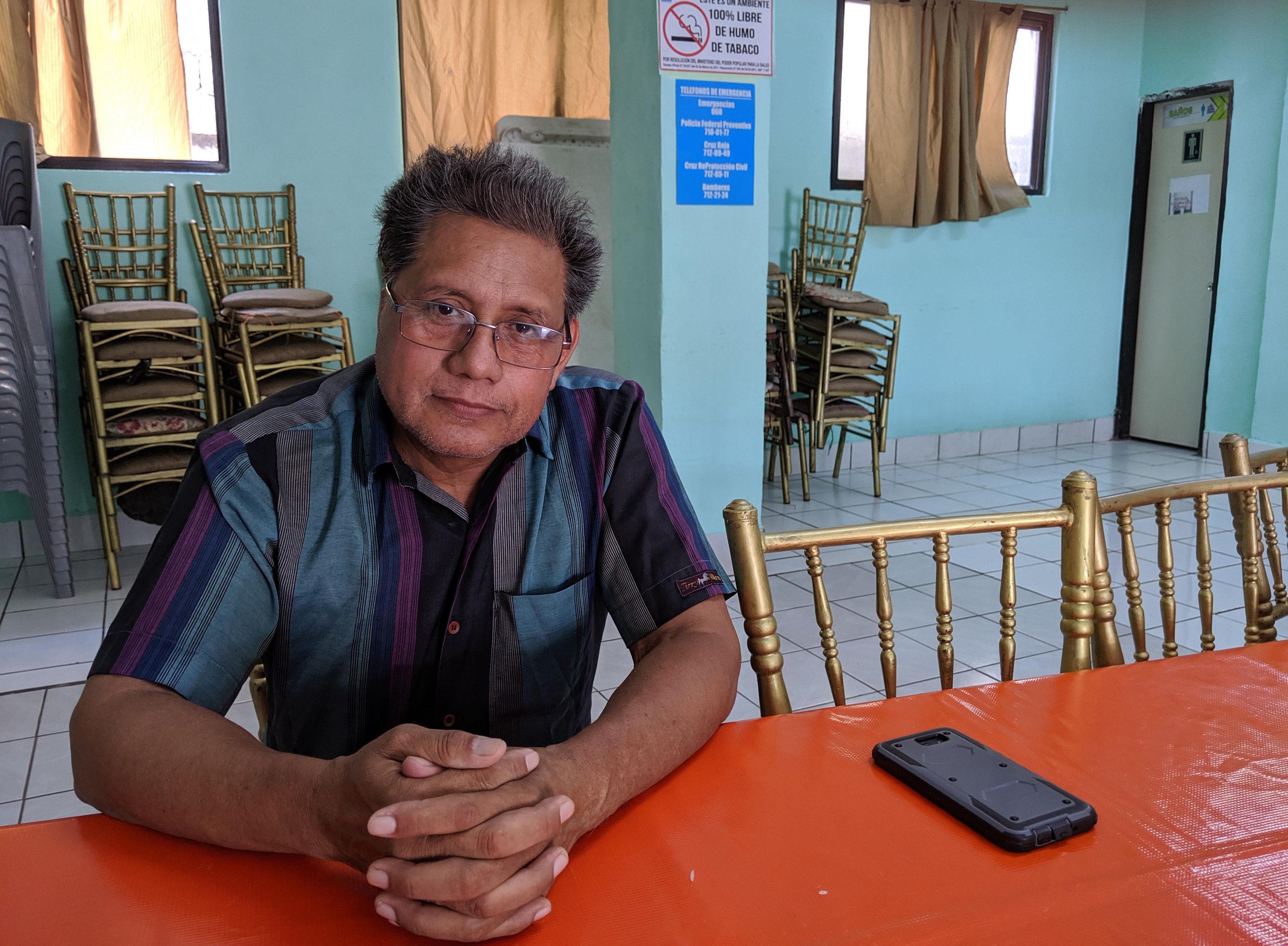
Immigration Judge Slams ‘Remain in Mexico’ Tent Courts
“It's more like what you might see, perhaps, in China or Russia,” says Ashley Tabaddor, president of the National Association of Immigration Judges.

Above: Migrants applying for asylum go through a processing area at a tent court facility in Laredo on September 17.
As of mid-September, more than 45,000 migrants have been returned to Mexico to await their court proceedings under the sweeping Trump policy known as the Migrant Protection Protocols (MPP). The measure—which rolled out in January in California before expanding to El Paso, Laredo, and Brownsville—has swiftly gutted the U.S. asylum system. Thousands of migrants have given up on their legal claims and returned home, rather than face kidnappings and violence in Mexico. And those who do make it to their court dates face a secretive, rushed, and skewed process that makes success extraordinarily difficult.
According to court data compiled by Syracuse University, less than 2 percent of migrants in MPP have found lawyers to represent them as of August 31. The same data show only two migrants in the program have won asylum.
In Laredo and Brownsville, the Department of Homeland Security (DHS) has taken the unusual step of building tent court facilities alongside the ports of entry. There, members of the press and public are barred from entry. Instead, journalists must go to the immigration courts in San Antonio, Harlingen, and other cities, where the judges hear the cases by video.

Last week, I observed two rounds of initial hearings in San Antonio, with the migrants themselves some 150 miles away in Laredo. Out of 120 migrants scheduled to appear, only 52 made it, and only five had attorneys. They expressed confusion about how to apply for asylum and other forms of relief, including how to get their documents translated into English as the law requires. Many said they had been kidnapped or assaulted in Mexico and pleaded not to be returned again. (While a process exists to get out of MPP based on danger in Mexico, vanishingly few migrants have succeeded.) More than once, the judges showed confusion or consternation with the MPP process, and I noted errors in the Spanish-English interpretation.
On Thursday, I spoke by phone with Ashley Tabaddor, an immigration judge in California and president of the National Association of Immigration Judges, about how MPP has undermined adjudication of immigration law. Tabaddor commented in her capacity as association president.
Texas Observer: From your perspective as association president, what problems do you see with this whole MPP court setup?
Ashley Tabaddor: We’ve seen a number of issues. One has to do with the sheer volume of cases that judges are being assigned, just [an] unsustainable demand to handle two, three times the cases that they would otherwise be assigned. It’s not unusual to have upwards of 80 or 100 cases scheduled for a session. Everybody’s exhausted, the judge is exhausted, the interpreters are exhausted. There isn’t much room or opportunity to delve beyond very basic issues. So it makes it very difficult for the judges to effectively and fairly go through these cases.
The other big issue has to do with the logistical challenges that the respondents have in trying to secure counsel, which means the judges have to bear the brunt of that shortfall. Essentially, the judges have to wear these dual hats because under immigration law, people don’t have a right to appointed counsel if they can’t afford one or get one. The judges have been tasked with trying to level the playing field a bit, making sure the person understands what’s happening, understands their rights and responsibilities. And that puts a great degree of onus on the judges. And there’s myriad other issues because we cannot contact the individuals directly. The court system is designed to be able to send correspondence directly to each party, and we can’t do that because there are no specific addresses for these individuals.
“We don’t do stuff behind closed doors. That is not what America is about. And yet with each [immigration] policy decision in the last three years, we are moving closer and closer to a model that doesn’t resemble anything in the American judicial system.”
In Matamoros and Nuevo Laredo, they’re just putting the same shelter as everyone’s address even though none, or almost none, of them are actually staying at that shelter.
Yeah, that’s definitely a problem. And the address that’s provided from the judges I heard in San Diego was something like “the neighborhood down the street in such town.” That’s the kind of address you would use if it’s a town of a hundred people, not Tijuana.
Then the other problem is with these new [tent] courts or soft sites, [immigration judges under the Department of Justice] are not controlling those sites. So we are 100 percent now essentially under the control of DHS when it comes to those courts. You cannot have a court run by a prosecutor. This is unimagined. And yet we find ourselves, instead of moving towards ensuring the independence of the immigration court and immigration judges, moving towards having less and less independence from DHS. They are controlling it, and we’ve been told that they’re restricting access.
They’re not allowing press or concerned community members. You really have to be a lawyer with your client and that’s it. And that’s not normal.
Normal immigration court is open to the public. In civil proceedings in America, one of the fundamental tenets of our judicial system is that there has to be accountability to the public. We don’t do stuff behind closed doors. That is not what America is about. And yet, with each [immigration] policy decision in the last three years, we are moving closer and closer to a model that doesn’t resemble anything in the American judicial system; it’s more like what you might see, perhaps, in China or Russia, countries that we hear asylum cases from, where judicial decisions are being made by prosecutors or at the direction or influence of prosecutors in the guise of a court. So it has become exceedingly problematic for the judges to try to stay true to their oaths of office.
What I’ve seen, watching proceedings in Laredo from San Antonio, is half or less of the respondents on the docket are even making it to their first hearing.
Some judges have serious concerns about whether the people have been given adequate information about the logistics of where they need to be and when. Whether they’re actually understanding what’s happening. Other times it could be that, frankly, they can’t make it because they’re miles and miles away from the border, so it’s very difficult for them to make it on time. Other times they just give up. We’ve heard that they cross into the United States, trying to avoid the whole thing because they can’t stand staying in Mexico. The logistical challenges are exponentially more difficult than when you are released into the [United States] or when you are, obviously, in detention. If you’re in detention, you always show up.
Is there any guidance as to whether y’all should ask if people are afraid of returning to Mexico, and then is there anything that y’all can do about it?
What I have heard from the judges is that they’re being told that they’re not to ask about it. And then also being told that if somebody does express it, that they should just refer the person back to DHS.
Read more from the Observer:
-
What the UAW Strike Looks Like, From Deep in the Heart of Anti-Union Texas: GM autoworkers from the Arlington plant, one of the company’s most profitable, are part of the largest strike against a U.S. business since 2007.
-
The Creature of Martin Creek Lake Won’t Die: The Martin Lake coal plant in East Texas is the biggest sulfur dioxide polluter in the nation. And unlike other regional super-polluters, this one is still chugging along.
-
The Roots of Narendra Modi’s Divisiveness Are at Odds With the Idea of a Diverse Houston: The “Howdy Modi” event is drawing criticism for welcoming the Indian prime minister amid human rights issues plaguing his country.


